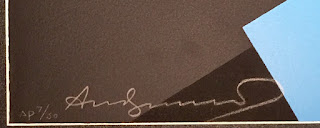Franz Kafka from Ten Portraits Of Jews Of The Twentieth Century, 1980; Screenprint in colors on Lenox Museum Board; Signed Andy Warhol and numbered AP 7/30 in pencil lower left; Published by Ronald Feldman Fine Arts, Inc., NY, Jonathan A Editions, Tel Aviv, Israel; Size - Sheet 40" x 32"; Catalog Raisonne: Feldman/Schellmann: II.226; Unframed.
Franz Kafka (July 3, 1883 – June 3, 1924) was born in Prague to a middle class Jewish family. He studied law and worked in the insurance industry when he began to write mainly in the evenings, before moving to Berlin in 1923. He passed away soon after the move of tuberculosis, and his good friend Max Brod published the vast majority of his work posthumously. Kafka wrote in German and was the author of both novels and short stories. At the time of his passing he was not highly regarded by his peers, however during WWII his work became highly regarded in German literary circles. He has since been viewed by critics as one of the most influential authors of the 20th century. Most of his works such as "Die Verwandlung" (The Metamorphosis), "Der Process" (The Trial), and "Das Schloss" (The Castle), deal with concepts of alienation, physical and psychological brutality, parent–child conflicts, mazes of bureaucracy, and mystical transformations. Kafka's influence extends to not only literature, but musical and theatrical compositions as well.
In October 1980, an exhibit featuring portraits of "famous Jews" opened at the Jewish Museum in New York and it featured silk-screen prints and acrylic paintings based on known photographs of the following Jewish figures: Gertrude Stein, Franz Kafka, Sarah Bernhardt, the Marx Brothers, Martin Buber, Louis Brandeis, George Gershwin, Sigmund Freud, Albert Einstein, and Golda Meir. The colors that were chosen, as well as the specific forms and their placement in the compositions, complimented the individual portraits perfectly. For instance, Albert Einstein was created from all black, white, and mainly grey colors; which was ideal for the "grey matter" of the brain. The Gershwin was wonderfully composed and reinforced the idea of musical lyricism. However, one of the most successful works in the set was Andy Warhol's portrait of Franz Kafka.
Publishers stamp verso.
From "Andy Warhol: His Kafka and "Jewish Geniuses", 2000" by Bluma Goldstein:
"On the one hand is the sociocultural and political significance of the confluence of Warhol's successful endeavor to market -- in a profitable venue -- the portraits of what he referred to in his diaries as "the Ten Jewish Geniuses" and the eagerness of major Jewish museums to mount and advertise the exhibit and to sell expensive portfolios of the exhibited serigraphs. On the other hand are the cultural and political implications of Warhol's rendition of one of the more interesting portraits, that of Franz Kafka, and the ways in which it supports a rather commonplace view of the writer by altering, even effacing the photo-graph on which the portrait is based and thereby also obscuring other, more complex, compelling readings of Kafka's life and writings, a practice shared by many interpreters of the writer and his work."
This work is an exception example of Andy Warhol at his best! The bold and somber blue tones, as well as the prism like triangular projects across the forehead and face, reflect the conflict in Kafka's writings. The sheet is in mint condition with the Publisher's stamp verso.



No comments:
Post a Comment